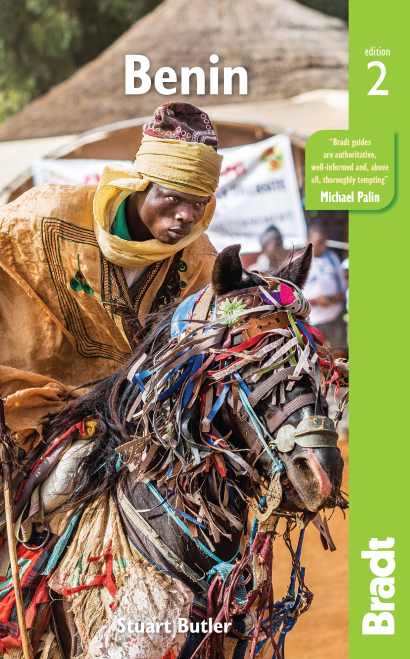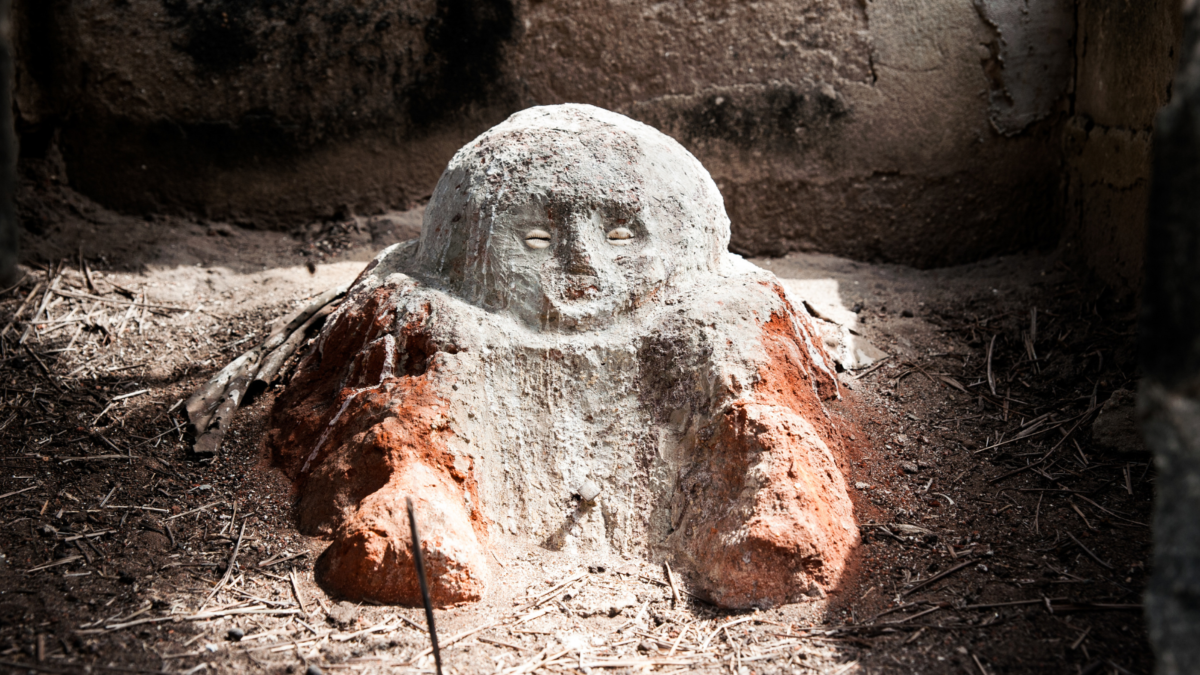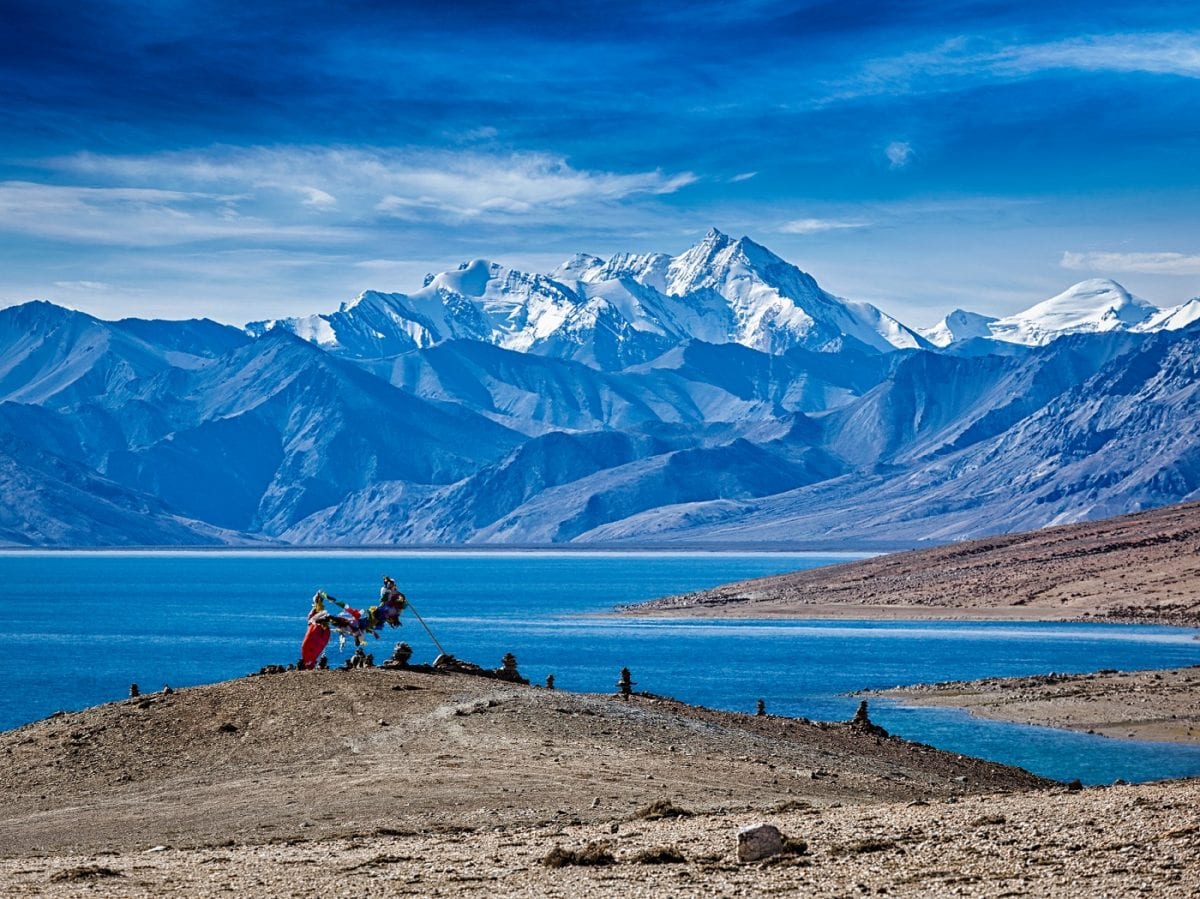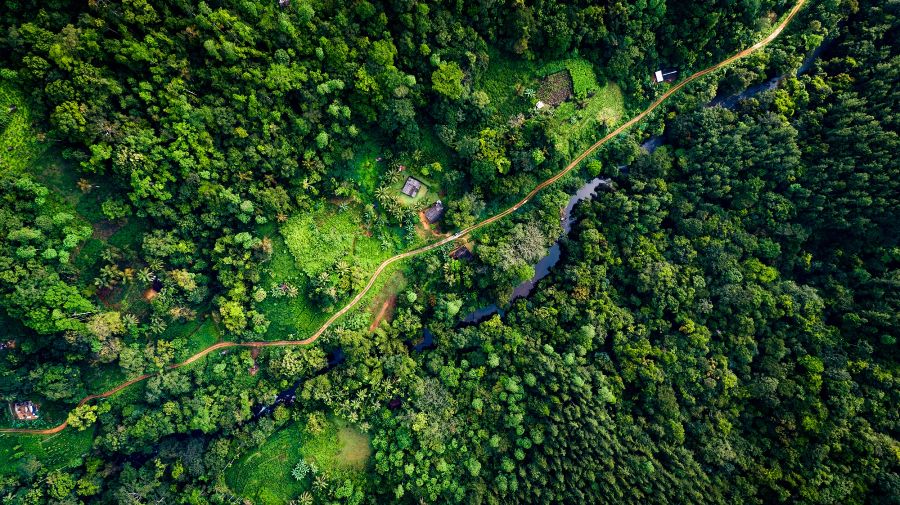Hidden away in the green folds of Africa, Benin is a small country that few westerners have thought to make a holiday destination, but we guarantee you that once visited it will forever leave you enchanted.
Stuart Butler, author of Benin: the Bradt Guide
Despite the extraordinary range of attractions, few westerners have thought to make Benin a holiday destination. But this West African nation offers so much to the adventurous traveller – the birthplace of the much-maligned and little-understood religion of Vodou (voodoo), it drips in ghosts and ghouls, wizards and monsters, giant talking haystacks, people who live in dolls houses and kings who can turn into trees on a whim.
And what makes this French-speaking country so special from a visitor’s perspective is that such characters are a visible part of day-to-day life and encounters with them will likely form the backbone of your Benin adventure.
But there is more than just storybook magic to this Benin. It is arguably the best wildlife destination in West Africa, with a huge array of birdlife and two of the finest parks this side of the continent where heart-in-the-mouth encounters with buffalo, elephant and lion are day-to-day events.
Need more? Well there’s a sad history of slavery that is visible in coastal forts and museums (many American visitors come here to trace their ancestral routes) and there’s a short, sharp strip of empty, palm-backed golden sand beaches, spicy, flavoursome food, loud and constant music and a warm and gregarious people drenched in day-glow colours.
To top it all off travelling here couldn’t be easier – the roads are good, distances small, transport efficient and hotels of a reasonable quality. It’s a very safe and politically stable place to travel, just a short and cheap flight from much of Europe.
For more information, check out our guide to Benin:
Food and drink in Benin
Food
For most Beninese, food is not something that you splash out lots of money on in order to have a divine culinary experience. Food is just something you need in order to survive and for that reason the average Beninese culinary experience is not something you will remember fondly for years to come. Having said that, the liberal use of spices and wide variety of ingredients means that Beninese food is considerably better than in many African countries.
In fact, Benin and neighbouring Togo are renowned throughout West Africa for having the best food in the region and the secret to Beninese cooking lies firmly in the sauce used, which is often fairly spicy.
Despite the fact that Beninese food has a good reputation in West Africa there are, like the cuisines of every nation, some decidedly unappealing delicacies such as okra (a green sludge that pops up with alarming frequency), giant snails which come without the garlic or in the easily downed bite-size nibbles of French escargots, and grasscutter (cane rat), a large rat-like rodent that in fact tastes much better than it sounds.
Away from such exotics you can expect most meals to consist of a starchy, filling staple draped in sauce and, if you pay a little more, a sprinkle of meat, though this is normally more fat and bone than succulent steak. Aside from agouti, bushmeat is very rarely eaten in Benin (unlike in some nearby countries where monkey and other ‘delicacies’ are found in many a meal).
Drinks
Whatever else you do in Benin you can rest assured that you’ll be knocking back the drinks. In a hot and sticky climate such as this you should, as a minimum, drink at least three litres a day just to replace the fluids lost through sweating.
Starting with the ubiquitous symbols of globalisation, Coca-Cola and its cousins Fanta and Sprite are available everywhere you look. You can go to the smallest, poorest village with next to nothing to eat anywhere and be almost certain of finding a bottle of Coke. Where the US versions aren’t available their place is normally taken by one of the several local companies producing their own versions of these same drinks though they are normally much sweeter and not quite as refreshing.
It doesn’t take long for these sugary drinks to lose their appeal and, fortunately for such times, you can often find bottled pineapple or mango juice or, for something a bit different, Moka, an iced coffee-style drink that takes a little getting used to but is more refreshing than most soft drinks.
Real lifesavers are the Songhai centres that can be found in a few towns; they often sell beautiful homemade natural juices (and yoghurts). On the coast someone can always be found chopping the heads off coconuts to provide a delicious, cold and healthy drink. Possotomè is the big name in mineral water. It comes from the town of the same name on the banks of Lac Ahémè and, should you really get into it, you can even arrange to visit their bottling plant there!
Health and safety in Benin
Health
Benin, like most parts of Africa, is home to several tropical diseases unfamiliar to people living in more temperate and sanitary climates. However, with adequate preparation, and a sensible attitude to malaria prevention, the chances of serious mishap are small.
To put this in perspective, your greatest concern after malaria should not be the combined exotica of venomous snakes, stampeding wildlife, gun-happy soldiers or the ebola virus, but something altogether more mundane: a road accident. Within Benin, a range of adequate (but well short of world-class) clinics, hospitals and pharmacies can be found around Cotonou and other major towns.
Facilities are far more limited and basic in rural areas. Doctors and pharmacists will generally only speak French, although at major hospitals in Cotonou a good English-speaking doctor can normally be found. Consultation and laboratory fees (in particular malaria tests) are inexpensive by international standards – so if in doubt, seek medical help.
Safety
Major hazards
People new to exotic travel often worry about tropical diseases, but it is accidents that are most likely to cart you off to hospital. Road accidents are very common in many parts of Benin, so be aware and do what you can to reduce risks: try to travel during daylight hours and refuse to be driven by a drunk.
Probably the biggest threat your to safety in Benin is while swimming in the sea, particularly during the wet season, when the water is rough and the currents strong. Many people drown each year and the so-called ‘lifeguards’ at Grand-Popo are nothing of the sort. Unless you are a very strong and experienced swimmer in rough waters then keep well away.
Female travellers
Benin is a very macho society and women travellers, especially those travelling alone, should expect some unwanted attention. In almost all cases this will be limited to men trying to start conversations with you, officials using their power to have more of your company than is really needed, and general whistling and cat-calls.
Sexual assault or rape against female travellers is very rare. Women should be careful if out in bars and clubs alone at night in the bigger towns, but the risk is really no greater and in fact normally less than you would face at home. However, things may change as tourism increases, and it’s certainly sensible to listen to local advice about any areas where violent (or petty) crime is rife.
Female hygiene items are only reliably available in Cotonou and possibly Parakou.
Travelling with a disability
Benin would be a very hard country for travellers with a disability to travel in. People will go out of their way to try and help you, but the simple fact of the matter is that there are no disabled facilities, pavements are non-existent, roads and paths rough, and elevators are only available in a few topend international chain hotels in Cotonou.
These same hotels are the only ones where you might find mobility-impaired rooms available. For further information, the UK’s gov.uk website provides general advice and practical information for travellers with disabilities preparing for overseas travel.
LGBTQ+ travellers
LGBTQ+ travellers should be very discreet. As with almost all sub-Saharan countries homosexuality is deeply – sometimes violently – frowned upon and most of sub-Saharan Africa simply does not believe that lesbianism exists.
On the positive side, it’s common for men to hold hands as a sign of friendship and for travellers (foreign or Beninese) of the same sex to share hotel rooms (but not beds), and so as long as there are no public displays of affection (other than hand holding), then few people would likely realise.
Travelling with children
Benin’s small size and generally reasonable roads and fairly comfortable hotels means that it’s one of the better West African countries for (very) adventurous family travel. However, it definitely suits older children (ten years plus) more than young children. Younger children are likely to find it too hot and humid and the towns are hardly child-friendly.
Travel and visas in Benin
Visas
For most people, three documents are required to enter Benin:
- a passport with at least six months’ validity left on it
- a valid visa
- a yellow-fever certificate
Standard tourist visas for Benin are easy to obtain for most Western nationalities although exact requirements vary from embassy to embassy. Visa rules and regulations seem to be in a state of flux at the moment and it’s important to check the information below with embassies and online in case it has changed. At the time of research visas were not available on arrival, and it was necessary to get a visa in advance either online or through the nearest Beninese embassy or consulate in your home country.
E-Visas
E-visa applications should be made through evisa.gouv.bj, and applications take 48 hours to process. You need to bring a printout of the visa with you to Benin. If, however, you still want to obtain a visa the old-fashioned way, then you will need to send or take your passport, a passport photo and a completed application form (available at the embassy) to your nearest embassy or consulate. Visa costs are normally the same as for the e-visa. Depending on the embassy or consulate, it might be possible to get the visa issued while you wait. In other cases, though, the embassy or consulate might just direct you to the e-visa website, so it’s wise to contact them in advance to check that they will issue you a visa (rather than direct you to the e-visa system).
Travel
Getting there and away
Overland
Those on an extended African overland adventure will arrive by land, through Togo, Burkina Faso, Niger or Nigeria, with the Togo route being the most commonly used. Togo and Nigeria both have multiple border-crossing points with Benin, virtually all of which can be used by tourists, though the most traffic is along the coastal routes which link Cotonou with Lagos and Lomé (all of which are open 24 hours).
By air
Air travel is a more likely option for those either arriving in Benin on business or holidaying exclusively in Benin and its neighbouring countries. Cotonou is the only airport in the country for international flights. A growing number of airlines are serving Cotonou, but even so the city is not a big name in the airline world.
Getting around
Not only is Benin a small and narrow country in which almost all places of interest are a short and direct journey from each other, but also, compared with those of many African nations, its road system is also relatively good. All main roads are surfaced, and though there are pot-holes they’re not generally as large and common as in many a neighbouring country.
Car hire
International agencies such as Hertz have offices in Cotonou, but car hire is generally very expensive; if you want to hire a vehicle that you drive yourself, you’ll need to use them. Otherwise local rental agencies and tour companies provide vehicles complete with driver, the cost of whose food and accommodation is generally (but not always) included in the price.
Taxis
Taxis in Benin are the most common form of public transport and they run to almost every town and village in the country. Between five and seven passengers are expected to squeeze, sardine-like, into the car alongside the driver who covers a set route. Seat prices are often (but not always – it all depends on supply and demand) higher than in a bus but in real terms are still cheap.
Buses
For longer journeys a bus is almost always preferable to a share taxi. Buses generally leave (roughly) on time and maintain a one-person, one-seat policy, which makes them far more comfortable than share taxis which like to try and squeeze around 8½ people on to each seat! Many of the better companies have airconditioned buses. Try and make bookings the day before, though if you can’t, don’t worry too much as there are normally seats going spare. The two best-regarded bus companies are ATT and Confort Lines.
Zemidjans
The normal way of getting around a town is on the back of one of the legions of zemidjans that buzz like flies around every town and village in the country. A zemidjan (or zemi as it’s normally referred to both in this book and in day-to-day speech) is a small motorbike on which the passenger sits precariously just behind the driver. If you have much luggage then they are near enough impossible to use – not that that will stop the driver from trying and, with or without luggage, they are for many tourists one of the worst aspects of Benin.
When to visit Benin
Benin has two very distinct seasons – the wet and the dry. These two seasons can be further sub-divided. The wet season corresponds to the northern hemisphere summer of May/June through to September, while the dry season fills the remaining months of the year. You might think that the best time to visit Benin is during the dry season and this would largely be true, but of course we’re talking about the weather so nothing is as simple as it seems.
The wet season for a start isn’t that wet – at least when compared with some of the other countries on the block. Sure, in the south at least, it rains most days and when it does so it’s impressively heavy, but this rain normally only lasts for an hour or so in the evening.
The good thing about the wet season is that it’s the coolest and greenest time of year and so for many people is actually quite pleasant. On the downside, though, the mosquitoes are out in force, some minor roads are impassable, the beaches are rough and not safe for swimming and the national parks are closed or very difficult to get about in.
In general, therefore, the best overall time to visit Benin is in the cool dry season running from October to December, with November being probably the best month as well as one of the quietest in terms of other tourists.
Apart from the weather factor, January can also be a good month to come, as this is when magic and Voodoo are at their most accessible thanks to the Voodoo Day celebrations on 10 January.
Climate
Sitting entirely in the northern hemisphere tropics, Benin has a wet tropical climate in the south dominated by a strong monsoon between late April and early October (though it can rain at any time) and high temperatures and humidity all year round.
The north is similar but its monsoonal rains are far weaker, humidity less and overall temperatures higher. In April and May the temperature frequently climbs to an overwhelming 45ºC and more! The rains here tend not to start until early June and are over by mid September; rainfall outside of the rainy season is far less likely in this region.
Things to see and do in Benin
Abomey
With walls made of blood and palaces containing thrones balanced on human heads, the royal city of Abomey is the gory Buckingham Palace of Benin and after Timbuktu and Zanzibar is one of the most celebrated of old African towns.
Its former name, Dahomey, is a French corruption of the original Fon word for the city, Danhomé, which means ‘In the belly of Dan’, and it was a name that was once whispered in fearful awe by the citizens of the surrounding kingdoms as well as in the civilised drawing rooms of 19th-century Europe.
It was a name that had enough chill in it to send a shiver down the spines of anyone who had ever crossed its path. Its kings, descended from the son of a princess who slept with a panther, were protected by the only genuine Amazon army the world has ever known, and they lived a life of extreme brutality.
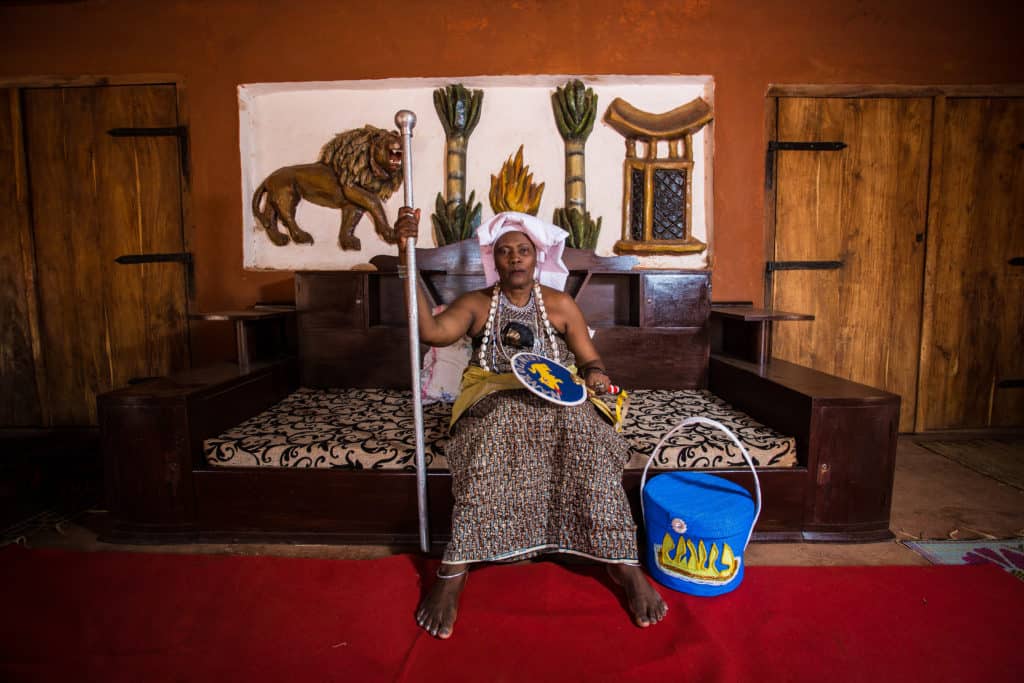
The walls of their city were festooned with the severed heads of enemies and former friends of whom they had grown tired. To relax they feasted on a harem of hundreds of virgin girls and for sport they fulfilled their coronation vows by expanding the size of the kingdom they had inherited through war. To fund it all, the many prisoners generated from this constant state of warfare were wrapped in chains and sold to the European slavers in Ouidah and other coastal towns.
For many years it was a city forbidden to foreigners and of those who were compelled to try to make it here, some in disguise and some on the invitation of the king, few returned to Europe to tell the tale.
It was a city that became so powerful that it gave even the French colonial machine a serious run for its money and it was a city of such doomed extravagance and wealth that inevitably it became no more than a name of legend and mystery and, like Timbuktu with its similar echoes of past grandeur, is to some extent a disappointment for the modern tourist. However, although the fear has faded and the old wealth and extravagance are now no more than an almost unimaginable dream, it still goes without saying that Abomey should be one of the first places you rush to in Benin.
Dassa-Zoumé
North of Bohicon Benin’s countryside loses much of its sheen of green and becomes noticeably drier with acacias and baobabs starting to replace the palms and bananas, and the population density thins dramatically. Of the few towns of note between Abomey and Parakou, Dassa-Zoumé, the town of 41 hills and normally known just as Dassa, is the largest and best organised for tourists. In fact, each August it becomes the biggest tourist centre in Benin as thousands of Catholic pilgrims descend on the grotto just outside of town where the Virgin Mary is said to have once appeared.
In addition to Christian spirits there are plenty of Voodoo spirits in the hills and, for tourists, there is walking or, a little further afield, wildlife spotting in the form of hippos. The best thing about Dassa-Zoumé, though, is the atmosphere; you start to feel the tempo downgrading from the often-hectic coastal lands into something altogether more relaxing.
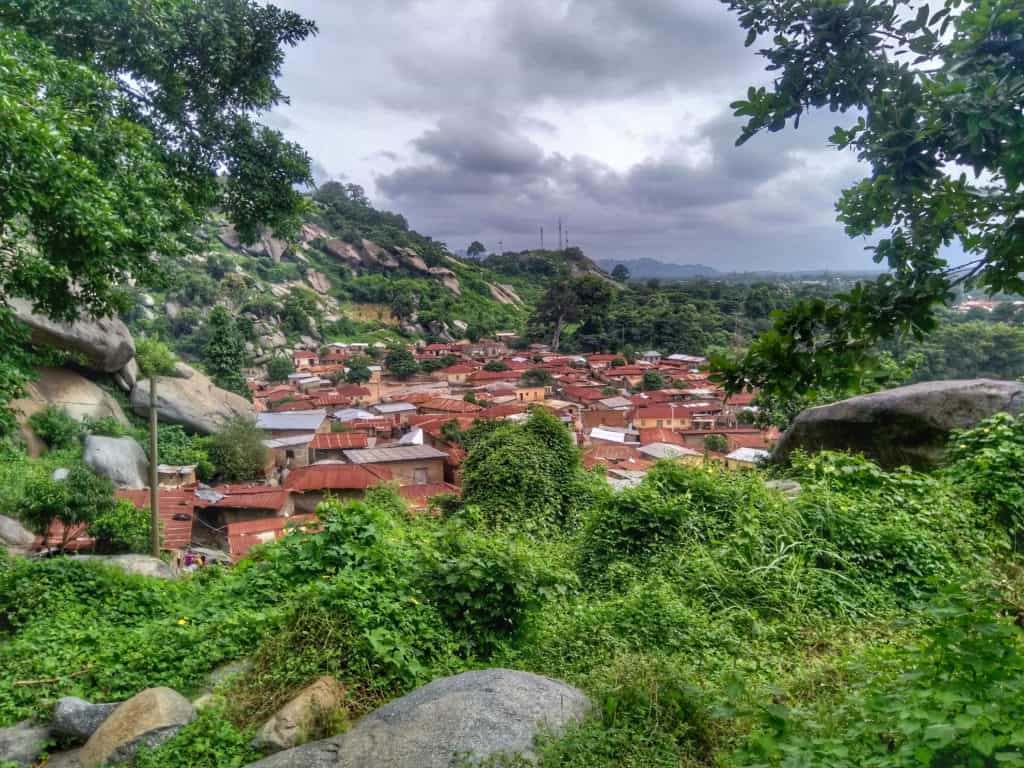
The town’s main attraction is the enormous basilica, a 10-minute walk south from the centre on the road to Bohicon. Built next to the grotto where, in 1954, a statue of the Virgin Mary is said to have miraculously appeared, the basilica was first opened in 2002 and, from behind, its architectural style appears to be loosely based around that of a multi-storey car park. Things don’t improve much inside. The great hall seems to contain as much religious feeling as a supermarket on a Saturday afternoon, but you’d be hard pushed to find a supermarket with such a memorable wall frieze – a giant crucifix bursting magnificently out of the clouds. The grotto, where the statue of the Virgin Mary appeared, is just beyond the basilica and is a little less tacky, though only marginally.
Behind the grotto a trail winds up into the hills past the 14 Stations of the Cross, each marked by a small statue. The pious are supposed to complete this by crawling on their hands and knees over the sharp granite rocks; today, though, most people are too busy taking selfies to do this. Services take place in the basilica every Sunday with the last one of the month being the busiest. During Christian religious holidays the basilica and grounds fill up with tens of thousands of pilgrims. The busiest time of all is during the three-day pilgrimage that culminates on 15 August. The faithful come from across West Africa and even Europe to attend. In 2002, Pope John-Paul II led Mass here during the pilgrimage.
Ganvié
Created with the aid of crocodiles, egrets and more than a little magic, the extraordinary aquatic stilt village of Ganvié has been called ‘the Venice of Africa’. This isn’t an entirely fair comparison, as you wouldn’t choose Ganvifor a romantic weekend, but it does get across the point that the village, sitting pretty on the 26,000ha Lac Nakoué, is one of a kind. Like in Venice, water and beauty are the overriding impressions, but unlike Venice, which feels like a manmade city in which water just happens to be all around, Ganvié seems to be nothing short of an organic creation – a town where nature went a little off the rails and the reeds and weeds just grew up into living houses, shops and a marketplace.
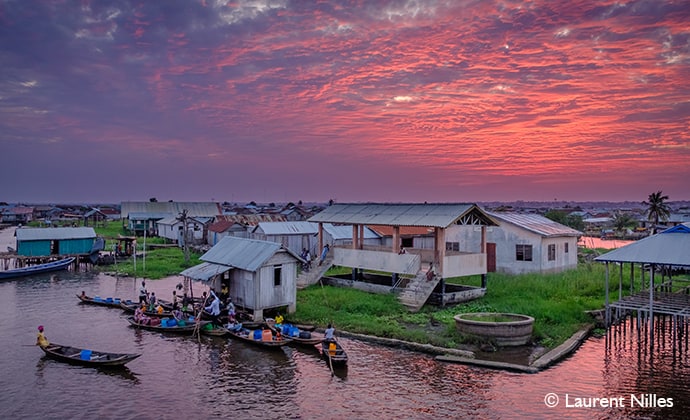
If Venice is dominated by water then Ganvié is positively drowning in the stuff and almost all of the houses are built not beside the water, but on it and above it. The locals eat on water, sleep on water and work and play on water. There can be few people so easy in the company of water as a Ganvié resident and, as a tourist attraction, it is second to none. This is a fact that has not gone unnoticed by Benin’s fledgling tourist industry and, alongside Abomey and Ouidah, Ganvié has become one of the highlights of Benin that you can be sure is on every visitor’s list of places to tick off. So, be prepared to rub shoulders with, well, maybe one other pirogue full of visitors. Yet, despite it being one of Benin’s, or maybe even West Africa’s, top attractions, you would be unfortunate if you found yourself sharing your visit here with more than half a dozen others.
Ouidah
If you arrive for the first time in Ouidah in the early morning or late afternoon, when the air is at its coolest, you will be struck immediately by the quality of the light. The deep colours of the houses radiate with a golden glow and the reds and purples of the people’s clothing seem to burn like flames. At a time such as this art and spirituality seem positively to ooze out of the very fabric of the town’s houses and religious buildings.
If, on the other hand, your first arrival in Ouidah is in the white heat of the middle of the afternoon, then your initial impressions will be very different. The energy of the town seems crushed, the noises of day-to-day life are strangely suppressed by the heat and the people are listless. Then it is not hard to see Ouidah as a town of pain and suffering.
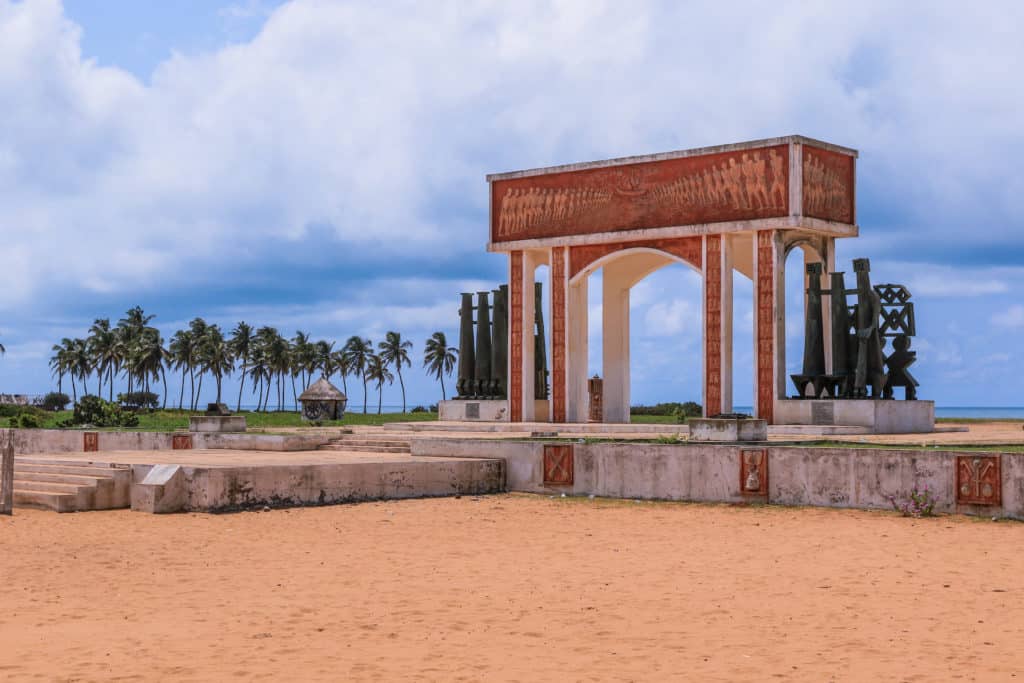
In fact, both of these first impressions are correct, for Ouidah is a town of extreme contrasts. It is one of the most infamous names in the Atlantic slave trade that dragged millions of beaten and broken Africans to the New World, but it is also the spiritual capital of the country with a thriving and lively Voodoo culture and, maybe because of the quality of the light, it is also something of a regional artistic centre. Whether your reasons for coming are a search for your roots, a search for magic, a search for art or just a search for the perfect spot to lie on the beach under a coconut tree, Ouidah will not disappoint.
For many people Ouidah is one of the main reasons for coming to Benin and the town learnt years ago how to look after these guests. This means that tourist facilities are better here than almost anywhere in the country. Despite an ever-increasing number of visitors, especially those from the diaspora returning to see the homeland of their ancestors, Ouidah never really feels overrun with tourists (except during the annual Voodoo festival). An almost compulsory read for every visitor is Bruce Chatwin’s brilliantly crafted semi-fictional novel, The Viceroy of Ouidah.
Parc National de la Pendjari
Lion, elephant and cheetah in West Africa? It’s commonly said that you go to East Africa for the wildlife and West Africa for the people. In many ways this is a fair comment, but in the Pendjari National Park this statement is turned on its head. On the scrubby plains of Pendjari it really is possible to see lion, elephant, cheetah and a host of other animals.
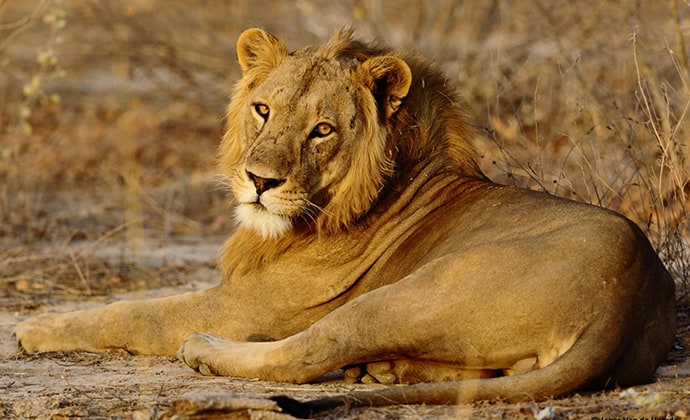
Created in 1961, added to UNESCO’s World Biosphere Reserves list in 1986 and made a UNESCO World Heritage Site in 2017, Pendjari is the largest remaining intact ecosystem in West Africa and a last refuge for a large number of West African animals. It is, quite simply, the greatest savannah national park in all of West and Central Africa and while it’s true that it cannot compete with Tanzania’s Serengeti National Park for the sheer number and variety of animals and scenic beauty, Pendjari is easily the equal of many other parks and reserves in eastern and southern Africa. And what’s more, thanks to recent international support and development (primarily through the acclaimed African Parks organisation), Pendjari is rapidly getting even better.
Almost every visitor will get to see elephant, buffalo, kob, waterbuck and hartebeest as well as a rainbow of different colourful birds. Anyone who spends more than a night or two here also has a very good chance of enjoying the thrill of staring wide-eyed at a lion. However, the cheetah take a bit more perseverance, as do leopards. We recommend spending two full days and a night inside the park to get the most out of it, better still three full days.
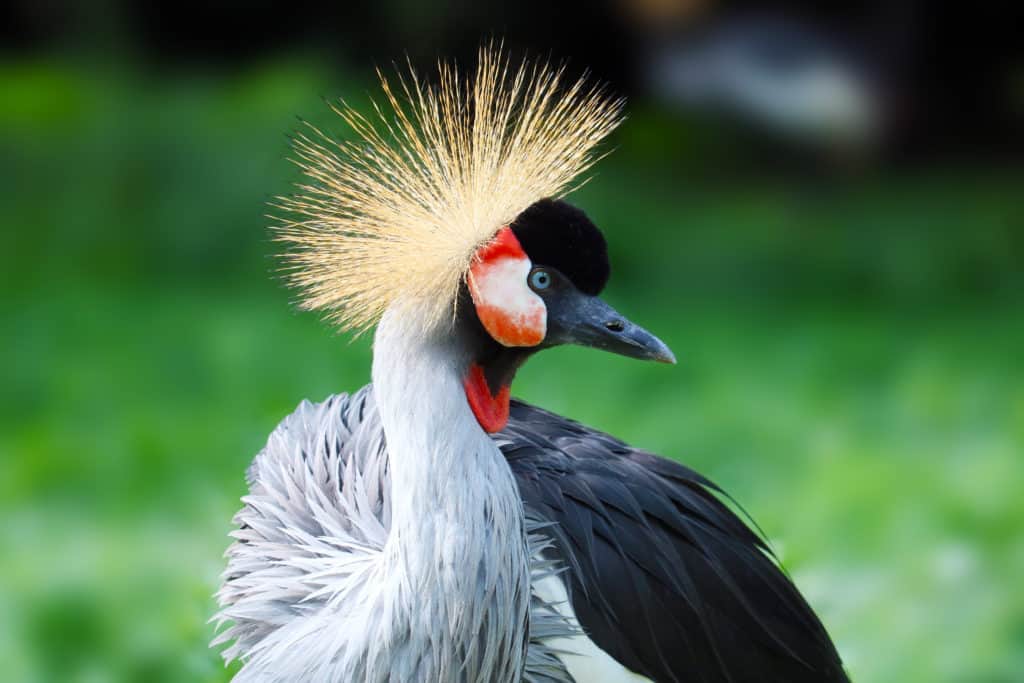
Pendjari is actually only one part of a much larger wilderness area that also incorporates Benin and Niger’s trans-boundary Parc National du W, and Burkina Faso’s Parc National d’Arli (it’s hoped that one day these will all merge into one huge trans-boundary park), but Pendjari is by far the easiest and most rewarding of all these parks to visit.
Porto-Novo
Porto-Novo is the political, if not commercial, capital of Benin. Yes, it’s hard to believe, because in comparison with Cotonou it seems like just a small and forgotten provincial town, but it’s true. In fact you have to feel a little bit sorry for Porto-Novo, because it really must struggle with feelings of insignificance. On the one side it’s got Cotonou, its younger, upstart neighbour 40 minutes to the west who’s gone and stolen all the facilities, all the jobs, all the entertainment and all the hopes; and an hour or so to the east, it’s chewed up, mashed about, digested and chucked back up by the immense belly of the city that is Lagos. But Porto-Novo isn’t overawed by its constantly growing cousins; in fact it just sits there coolly claiming to be the capital that, in all but paper, it is not. And it’s all the more endearing for it.
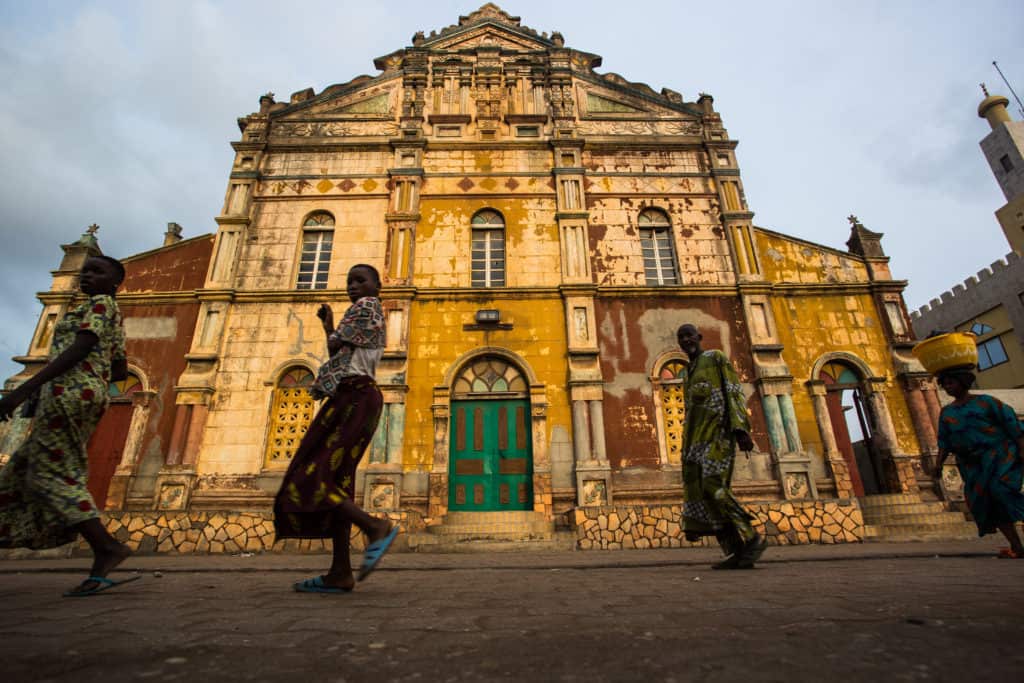
Porto-Novo is often overlooked in most visitors’ itineraries, which is a real shame because in many ways it’s actually the most interesting urban centre in the country as well as one of the most physically attractive.
Possotomè and Lac Ahémè
One small frustration of travelling around Benin (or almost any other African country for that matter) on public transport is the difficulty of seeing anything more than a fleeting glimpse of rural village life through a dirty bus window and not actually being able to stop and soak it in properly. This is somewhat ironic as most people don’t come to Africa to visit big, polluted cities; they want to spend time in the little villages. If you have your own transport then this is not a problem and Benin is littered with hundreds of villages you can stop off in, but if you are travelling around south Benin on public transport then Possotomè, home of the ubiquitous mineral water, might be the best chance you get to have a close look at the day-to-day events of a small village.
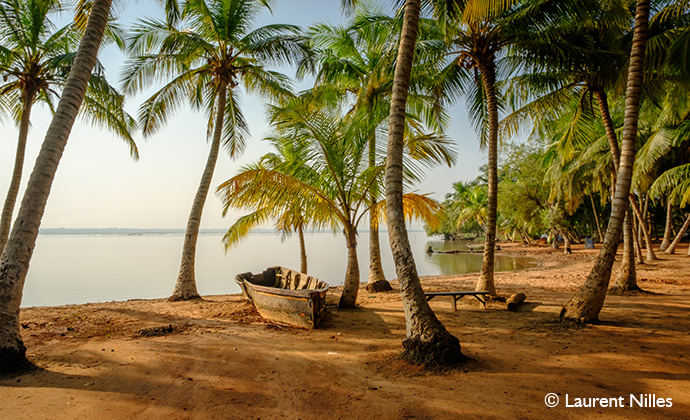
Set on a deliciously green hill just above Lac Ahémè, Possotomè is a wonderfully friendly little village that offers a number of interesting excursions out on the lake or to nearby night markets. It is highly recommended if you find Grand-Popo just not quite what you came to Africa for. There are no real facilities of any sort in the village, so come prepared.
Tanéka Koko
There are a number of villages scattered over the rocky and scrubby landscape around Djougou, but only one, Tanéka Koko, welcomes visitors. With mud-and-wattle houses and thatched roofs spirited away under the shade of big trees, the village appears from a distance to be just like any other in Africa. However, once inside you will realise that all of the buildings are actually far smaller than you originally thought – it’s hard to believe that anyone can actually fit inside the houses. It’s as if the entire village has shrunk in the wash.
Though their houses and villages might be very different from those of the more famous Somba to the north, the two groups retain a lot of cultural similarities as well as much of their traditional tribal lifestyle. However, today the modern world has started to catch up with the Tanéka villages and people and while the headman and the healers (of which there are several, each of whom specialises in a different illness) might spend their days sitting around the village smoking long bone pipes, wearing animal fur clothes (and, one gets the impression, waiting for passing tourists …), most of the remaining population wear T-shirts and trousers and live in larger, brick- and tin-roofed houses, located just down the hill from the original village.
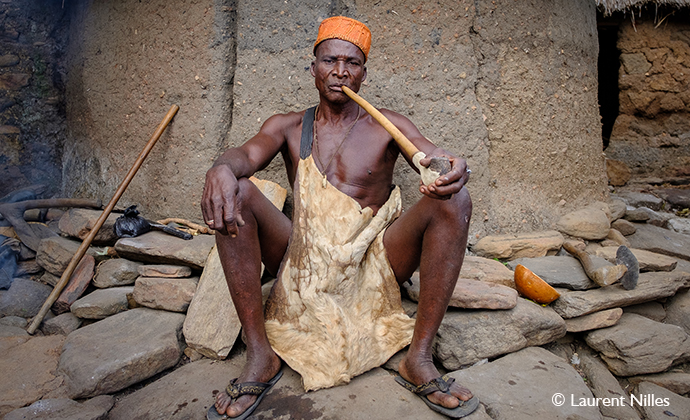
Many of the local young people also leave the Tanéka villages as soon as they can in search of brighter financial prospects in the big cities. Even so, the most important people in the community remain the headman and the healers and some old customs are still very much alive. On one of the days we visited we witnessed a male circumcision ceremony and other ceremonies and festivals are fairly common. These are often linked to important coming-of-age dates and harvests.
Tata Somba Villages
Southwest of Natitingou a minor road winds through the Atakora Mountains, whose heights reach only a very modest 658m. Nevertheless, in a country as flat as Benin this is pretty exciting stuff and the scenery, it cannot be denied, is very impressive. It is best appreciated at the very southern edge of the escarpment, at the viewing platform known by the tongue-twisting name of Koussakouangou.
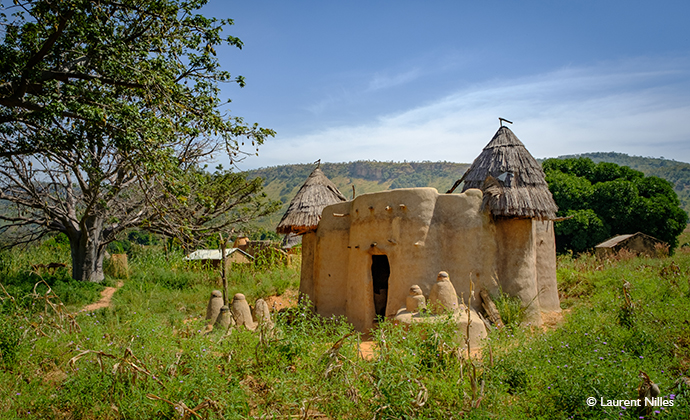
Try to get here for the early morning when the air is likely to be at its clearest and the views, right across the Somba country and off into nearby Togo, at their best. From here the road bends, corkscrew like, down off the plateau, depositing you finally at the village of Boukoumbé, which is the launching pad for the largest concentration of Tata Sombas, those truly unique fortified houses inhabited by a people who, until very recently, have kept their tribal traditions alive and pure.
Related books
For more information, check out our guide to Benin:
Related articles
This animistic religion has over 50 million followers in West Africa.
From boiling lakes to vast alpine bodies of water, these are our favourite lakes from around the world.
Covering even more of the world than our guidebooks, forests are ubiquitous but almost always different.
